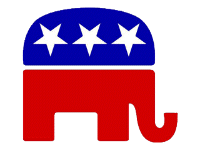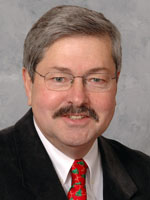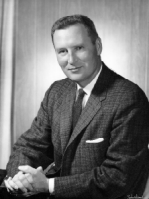Republican Dominance over Upper Midwestern Governorships through the Years
Republicans have controlled the governor’s mansions of IA, MN, ND, SD, and WI for over 72 percent of the time since 1846

A Smart Politics study of 311 Upper Midwestern gubernatorial elections finds that Republicans have been in power 72.3 percent of the time across Iowa, Minnesota, the Dakotas, and Wisconsin, with Democrats governing just 23.4 percent of the time, and other parties at 4.3 percent.
By the end of 2010, Republicans will have been in office for a collective 522 years and 4 months in the five-state region, compared to just 168 years and 11 months for Democrats, and 31 years and 1 month for other parties.
Partisan Control of Upper Midwestern Governorships by Length of Service
|
State
|
GOP
|
Democrat
|
Other
|
|
IA
|
73.8%
(121 yr, 1 mo) |
24.3%
(39 yr, 11 mo) |
1.9%
(3 yr, 1 mo) |
|
MN
|
69.1%
(105 yr, 5 mo) |
21.8%
(33 yr, 3 mo) |
9.2%
(14 mo) |
|
ND
|
63.7%
(77 yr, 2 mo) |
33.0%
(40 yr) |
3.3%
(4 yr) |
|
SD
|
81.9%
(99 yr, 10 mo) |
14.8%
(18 yr) |
3.3%
(4 yr) |
|
WI
|
73.1%
(118 yr, 10 mo) |
23.2 %
(37 yr, 9 mo) |
3.7%
(6 yr) |
|
Total
|
72.3%
(522 yr, 4 mo) |
23.4 %
(168 yr, 11 mo) |
4.3%
(31 yr, 1 mo) |
Data compiled by Smart Politics.
Republicans have had their greatest success in South Dakota – governing the Mount Rushmore State for 81.9 percent of the time (99 years, 10 months) during the 121+ years since statehood.
With the election of Dennis Daugaard in 2010, South Dakota will extend its longest-in-the-nation streak of consecutive Republican governors from 32 to 36 years, with the last Democrat elected in 1974 (Richard Kneip).
Democrats have been in power just 18 years in South Dakota (14.8 percent), with third parties running the executive branch for four years (3.3 percent).
The Republican Party has had its next best success in Iowa – the oldest state in the region, and one of two that entered the Union before the birth of the Republican Party.
The GOP has held Iowa’s governor’s office for 121 years and 1 month, or 73.8 percent of the time since statehood.

The 12-year reign of Culver and his predecessor Tom Vilsack was the second longest gubernatorial stretch of Democratic control in the entire five-state region across the last 165 years.
Democrats have governed Iowa for 39 years and 11 months, or just 24.3 percent of the time, with other parties governing the state for 3 years and 1 month (1.9 percent).
Wisconsin voters – who return Republicans to power in 2011 with the election of Scott Walker in that state’s open seat race – have backed Republicans for the state’s chief executive office the third most in the region.
Republicans have governed Wisconsin for 118 years and 10 months, or 73.1 percent of the time since statehood in 1848.
The GOP has had several long stretches of control over the Badger State’s 162-year history, including a 33-year stretch from 1895-1932, a 20-year run from 1939-1958, and a 16-year reign from 1987-2002.
Democrats have governed Wisconsin for only 37 years and 9 months, or 23.2 percent of the time, with other parties governing for a total of six years (3.7 percent).
Pending the result of the statewide recount, the nation’s third-longest Democratic gubernatorial drought will end in Minnesota with the election of DFLer Mark Dayton.
Republicans have governed Minnesota for 105 years and 5 months, or 69.1 percent of the time since statehood in 1858.
The longest GOP reign in the Gopher State was 39 years, from 1860-1898, with a 16-year stretch from 1939-1954 and a 15-year run from December 1915 to 1930.
This nearly four decade hold on the state’s chief executive office is the longest across the five-state region over the last 165 years.
Democrats (or the DFL) have governed Minnesota for 33 years and 3 months, or 21.8 percent of the time, with third parties boasting a region-best 14 years in office (9.2 percent).
Although North Dakota will enter 2011 with the third longest Republican gubernatorial streak in the nation at 18+ years and counting, the Democratic Party has actually had its greatest regional success for governorships in the Peace Garden State.
Republicans have governed North Dakota for 77 years and 2 months, or 63.7 percent of the time since statehood in November 1889.

The election of William Guy (pictured) to four terms and Arthur Link to two terms during this span is the longest Democratic hold on the governor’s office in history for any state in the region.
Overall, as the table below demonstrates, Republicans have thoroughly dominated the region, holding a majority of governorships for more than 80 percent of the time since the Upper Midwest became a five-state region just over 121 years ago in 1889.
Partisan Control of Upper Midwestern Governorships Since 1889
|
Partisan divide
|
Period
|
Percent
|
|
5 GOP, 0 Dem
|
37 years, 5 months
|
30.9
|
|
4 GOP, 1 Dem
|
25 years, 1 month
|
20.7
|
|
3 GOP, 2 Dem
|
24 years, 8 months
|
20.4
|
|
1 GOP, 4 Dem
|
11 years, 10 months
|
9.8
|
|
3 GOP, 1 Dem, 1 other
|
5 years
|
4.1
|
|
2 GOP, 3 Dem
|
4 years, 2 months
|
3.4
|
|
4 GOP, 0 Dem, 1 other
|
4 years
|
3.3
|
|
3 GOP, 0 Dem, 2 other
|
2 years
|
1.7
|
|
1 GOP, 1 Dem, 3 other
|
2 years
|
1.7
|
|
1 GOP, 3 Dem, 1 other
|
2 years
|
1.7
|
|
1 GOP, 2 Dem, 2 other
|
2 years, 1 month
|
1.6
|
|
2 GOP, 2 Dem, 1 other
|
1 year
|
0.8
|
|
0 GOP, 3 Dem, 2 other
|
1 month
|
0.1
|
Data compiled by Smart Politics.
Since 1889, there have been more Republican governors than Democratic governors for 98 years and 2 months.
There have been more Democratic than Republican governors for just 20 years and 2 months during this 121-year stretch, and the same number for three years (1893, 1937-1938).
The first time Democrats outnumbered Republicans in the governor’s office in the five-state Upper Midwestern region was after the Election of 1932, when Democrats were elected in Iowa (Clyde Herring), South Dakota (Tom Berry), and Wisconsin (Albert Schmedeman).
The last time Democrats controlled a majority of governorships in the region was after the Election of 1984, when they won the gubernatorial contest in North Dakota (George Sinner) after previously winning in 1982 in Minnesota (Rudy Perpich) and Wisconsin (Anthony Earl).
At least one Republican governor has been in office in the Upper Midwest since 1889 – save for a controversial one month period after the Election of 1934.
In that race, Democrats were elected in Iowa (Clyde Herring) and South Dakota (Tom Berry), with a Progressive winning in Wisconsin (Philip Fox La Follette) and a Farmer-Laborite in Minnesota (Floyd Olson).
Although a Democrat also won North Dakota (Thomas Moodie) – shutting out the GOP for the first time in the five state region that cycle – it was later determined he was ineligible to run for office, having not established proper residency requirements.
As a result, Republican Lieutenant Governor Walter Welford became governor, and at least one GOPer has governed in the region ever since.
Partisan Control of Upper Midwestern Governorships by State, 1846-Present
|
Period
|
IA
|
MN
|
ND
|
SD
|
WI
|
|
Dec 1846-Jun 1848
|
Dem
|
—
|
—
|
—
|
—
|
|
Jun 1848-Dec 1850
|
Dem
|
—
|
—
|
—
|
Dem
|
|
Dec 1850-Dec 1852
|
Dem
|
—
|
—
|
—
|
Dem
|
|
Jan 1852-Dec 1854
|
Dem
|
—
|
—
|
—
|
Whig
|
|
Jan 1854-Jan 1856
|
Whig
|
—
|
—
|
—
|
Dem
|
|
Jan 1856-Mar 1856
|
Whig
|
—
|
—
|
—
|
Dem
|
|
Mar 1856-Jan 1858
|
Whig
|
—
|
—
|
—
|
GOP
|
|
Jan 1858-May 1858
|
GOP
|
—
|
—
|
—
|
GOP
|
|
May 1858-Jan 1860
|
GOP
|
Dem
|
—
|
—
|
GOP
|
|
Jan 1860-Jan 1862
|
GOP
|
GOP
|
—
|
—
|
GOP
|
|
Jan 1862-Jan 1864
|
GOP
|
GOP
|
—
|
—
|
GOP
|
|
Jan 1864-Jan 1866
|
GOP
|
GOP
|
—
|
—
|
GOP
|
|
Jan 1866-Jan 1868
|
GOP
|
GOP
|
—
|
—
|
GOP
|
|
Jan 1868-Jan 1870
|
GOP
|
GOP
|
—
|
—
|
GOP
|
|
Jan 1870-Jan 1872
|
GOP
|
GOP
|
—
|
—
|
GOP
|
|
Jan 1872-Jan 1874
|
GOP
|
GOP
|
—
|
—
|
GOP
|
|
Jan 1874-Jan 1876
|
GOP
|
GOP
|
—
|
—
|
Dem
|
|
Jan 1876-Jan 1878
|
GOP
|
GOP
|
—
|
—
|
GOP
|
|
Jan 1878-Jan 1880
|
GOP
|
GOP
|
—
|
—
|
GOP
|
|
Jan 1880-Jan 1882
|
GOP
|
GOP
|
—
|
—
|
GOP
|
|
Jan 1882-Jan 1884
|
GOP
|
GOP
|
—
|
—
|
GOP
|
|
Jan 1884-Jan 1886
|
GOP
|
GOP
|
—
|
—
|
GOP
|
|
Jan 1886-Jan 1888
|
GOP
|
GOP
|
—
|
—
|
GOP
|
|
Jan 1888-Mar 1889
|
GOP
|
GOP
|
—
|
—
|
GOP
|
|
Mar 1889-Nov 1889
|
GOP
|
GOP
|
—
|
GOP
|
GOP
|
|
Nov 1889-Feb 1990
|
GOP
|
GOP
|
GOP
|
GOP
|
GOP
|
|
Feb 1990-Jan 1891
|
Dem
|
GOP
|
GOP
|
GOP
|
GOP
|
|
Jan 1891-Jan 1893
|
Dem
|
GOP
|
GOP
|
GOP
|
Dem
|
|
Jan 1893-Jan 1894
|
Dem
|
GOP
|
Populist
|
GOP
|
Dem
|
|
Jan 1894-Jan 1895
|
GOP
|
GOP
|
Populist
|
GOP
|
Dem
|
|
Jan 1895-Jan 1897
|
GOP
|
GOP
|
GOP
|
GOP
|
GOP
|
|
Jan 1897-Jan 1899
|
GOP
|
GOP
|
GOP
|
People’s
|
GOP
|
|
Jan 1899-Jan 1901
|
GOP
|
Dem-
People’s |
GOP
|
Fusion
|
GOP
|
|
Jan 1901-Jan 1903
|
GOP
|
GOP
|
GOP
|
GOP
|
GOP
|
|
Jan 1903-Jan 1905
|
GOP
|
GOP
|
GOP
|
GOP
|
GOP
|
|
Jan 1905-Jan 1907
|
GOP
|
Dem
|
GOP
|
GOP
|
GOP
|
|
Jan 1907-Sep 1909
|
GOP
|
Dem
|
Dem
|
GOP
|
GOP
|
|
Sep 1909-Jan 1911
|
GOP
|
GOP
|
Dem
|
GOP
|
GOP
|
|
Jan 1911-Jan 1913
|
GOP
|
GOP
|
Dem
|
GOP
|
GOP
|
|
Jan 1913-Jan 1915
|
GOP
|
GOP
|
GOP
|
GOP
|
GOP
|
|
Jan 1915-Dec 1915
|
GOP
|
Dem
|
GOP
|
GOP
|
GOP
|
|
Dec 1915-Jan 1917
|
GOP
|
GOP
|
GOP
|
GOP
|
GOP
|
|
Jan 1917-Jan 1919
|
GOP
|
GOP
|
GOP
|
GOP
|
GOP
|
|
Jan 1919-Jan 1921
|
GOP
|
GOP
|
GOP
|
GOP
|
GOP
|
|
Jan 1921-Jan 1923
|
GOP
|
GOP
|
GOP
|
GOP
|
GOP
|
|
Jan 1923-Jan 1925
|
GOP
|
GOP
|
GOP
|
GOP
|
GOP
|
|
Jan 1925-Jan 1927
|
GOP
|
GOP
|
GOP
|
GOP
|
GOP
|
|
Jan 1927-Jan 1929
|
GOP
|
GOP
|
GOP
|
Dem
|
GOP
|
|
Jan 1929-Jan 1931
|
GOP
|
GOP
|
GOP
|
Dem
|
GOP
|
|
Jan 1931-Jan 1933
|
GOP
|
F-L
|
GOP
|
GOP
|
GOP
|
|
Jan 1933-Jan 1935
|
Dem
|
F-L
|
GOP
|
Dem
|
Dem
|
|
Jan 1935-Feb 1935
|
Dem
|
F-L
|
Dem
|
Dem
|
Prog
|
|
Feb 1935-Jan 1937
|
Dem
|
F-L
|
GOP
|
Dem
|
Prog
|
|
Jan 1937-Jan 1939
|
Dem
|
F-L
|
Indep.
|
GOP
|
Prog
|
|
Jan 1939-Jan 1941
|
GOP
|
GOP
|
Dem
|
GOP
|
GOP
|
|
Jan 1941-Jan 1943
|
GOP
|
GOP
|
Dem
|
GOP
|
GOP
|
|
Jan 1943-Jan 1945
|
GOP
|
GOP
|
Dem
|
GOP
|
GOP
|
|
Jan 1945-Jan 1947
|
GOP
|
GOP
|
GOP
|
GOP
|
GOP
|
|
Jan 1947-Jan 1949
|
GOP
|
GOP
|
GOP
|
GOP
|
GOP
|
|
Jan 1949-Jan 1951
|
GOP
|
GOP
|
GOP
|
GOP
|
GOP
|
|
Jan 1951-Jan 1953
|
GOP
|
GOP
|
GOP
|
GOP
|
GOP
|
|
Jan 1953-Jan 1955
|
GOP
|
GOP
|
GOP
|
GOP
|
GOP
|
|
Jan 1955-Jan 1957
|
GOP
|
DFL
|
GOP
|
GOP
|
GOP
|
|
Jan 1957-Jan 1959
|
Dem
|
DFL
|
GOP
|
GOP
|
GOP
|
|
Jan 1959-Jan 1961
|
Dem
|
DFL
|
GOP
|
Dem
|
Dem
|
|
Jan 1961-Jan 1963
|
GOP
|
GOP
|
Dem
|
GOP
|
Dem
|
|
Jan 1963-Mar 1963
|
Dem
|
GOP
|
Dem
|
GOP
|
Dem
|
|
Mar 1963-Jan 1965
|
Dem
|
DFL
|
Dem
|
GOP
|
Dem
|
|
Jan 1965-Jan 1967
|
Dem
|
DFL
|
Dem
|
GOP
|
GOP
|
|
Jan 1967-Jan 1969
|
Dem
|
GOP
|
Dem
|
GOP
|
GOP
|
|
Jan 1969-Jan 1971
|
GOP
|
GOP
|
Dem
|
GOP
|
GOP
|
|
Jan 1971-Jan 1973
|
GOP
|
DFL
|
Dem
|
Dem
|
Dem
|
|
Jan 1973-Jan 1975
|
GOP
|
DFL
|
Dem
|
Dem
|
Dem
|
|
Jan 1975-Jan 1977
|
GOP
|
DFL
|
Dem
|
Dem
|
Dem
|
|
Jan 1977-Jan 1979
|
GOP
|
DFL
|
Dem
|
Dem
|
Dem
|
|
Jan 1979-Jan 1981
|
GOP
|
GOP
|
Dem
|
GOP
|
GOP
|
|
Jan 1981-Jan 1983
|
GOP
|
GOP
|
GOP
|
GOP
|
GOP
|
|
Jan 1983-Jan 1985
|
GOP
|
DFL
|
GOP
|
GOP
|
Dem
|
|
Jan 1985-Jan 1987
|
GOP
|
DFL
|
Dem
|
GOP
|
Dem
|
|
Jan 1987-Jan 1989
|
GOP
|
DFL
|
Dem
|
GOP
|
GOP
|
|
Jan 1989-Jan 1991
|
GOP
|
DFL
|
Dem
|
GOP
|
GOP
|
|
Jan 1991-Dec 1992
|
GOP
|
GOP
|
Dem
|
GOP
|
GOP
|
|
Dec 1992-Jan 1993
|
GOP
|
GOP
|
GOP
|
GOP
|
GOP
|
|
Jan 1993-Jan 1995
|
GOP
|
GOP
|
GOP
|
GOP
|
GOP
|
|
Jan 1995-Jan 1997
|
GOP
|
GOP
|
GOP
|
GOP
|
GOP
|
|
Jan 1997-Jan 1999
|
GOP
|
GOP
|
GOP
|
GOP
|
GOP
|
|
Jan 1999-Jan 2001
|
Dem
|
Reform
|
GOP
|
GOP
|
GOP
|
|
Jan 2001-Jan 2003
|
Dem
|
Reform
|
GOP
|
GOP
|
GOP
|
|
Jan 2003-Jan 2005
|
Dem
|
GOP
|
GOP
|
GOP
|
Dem
|
|
Jan 2005-Jan 2007
|
Dem
|
GOP
|
GOP
|
GOP
|
Dem
|
|
Jan 2007-Jan 2009
|
Dem
|
GOP
|
GOP
|
GOP
|
Dem
|
|
Jan 2009-Jan 2011
|
Dem
|
GOP
|
GOP
|
GOP
|
Dem
|
|
Jan 2011-Jan 2013
|
GOP
|
DFL
|
GOP
|
GOP
|
GOP
|
Data compiled by Smart Politics.
Follow Smart Politics on Twitter.

Not to ‘pettyfog’ too much on this, but the historically impressive William Lewis Guy – Arthur Albert Link gubernatorial reign from 01 of 1961 to 01 of 1981 is that of the DEMOCRATIC-NONPARTISAN LEAGUE party, which was created as a result of two distinct parties in the mid-1950s (analogous to the Liberal Democrats of the UK, a merger of the old Liberal and Social Democratic parties).
The last “Democrat” (pre-merger) to win and serve as governor is John Moses, who is also the first, last, and only Democrat ever to win (and briefly serve in) a US Senate election by direct popular vote, in 1944, the same year that the D-Farmer-Labor Party was born.